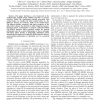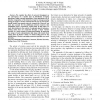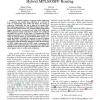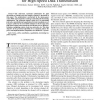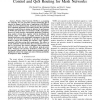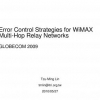81
Voted
GLOBECOM
2009
IEEE
15 years 4 months ago
2009
IEEE
This paper introduces a new framework of the multiple-input multiple-output (MIMO) detection in iterative receivers. Unlike the conventional methods processing with symbol lattice,...
102
click to vote
GLOBECOM
2009
IEEE
15 years 4 months ago
2009
IEEE
We consider the effect of network throughput on the convergence of a specific class of distributed averaging algorithms, called consensus algorithms. These algorithms rely on itera...
94
Voted
GLOBECOM
2009
IEEE
15 years 4 months ago
2009
IEEE
Secure communications in wireless ad hoc networks require setting up end-to-end secret keys for communicating node pairs. Due to physical limitations and scalability requirements, ...
GLOBECOM
2009
IEEE
15 years 4 months ago
2009
IEEE
In this paper, we consider the energy-efficient resource allocation that minimizes a general cost function of average user powers in wireless networks. A class of so-called -fair c...
116
Voted
GLOBECOM
2009
IEEE
15 years 4 months ago
2009
IEEE
Energy efficiency has become a critical concern in designing high speed packet classification engines for next generation routers. Although TCAM-based solutions can provide high th...
134
click to vote
GLOBECOM
2009
IEEE
15 years 4 months ago
2009
IEEE
A common objective of Internet traffic engineering is to minimize the maximal link utilization in a network in order to accommodate more traffic and reduce the chance of congestion...
GLOBECOM
2009
IEEE
15 years 4 months ago
2009
IEEE
The unit-norm constraint optimization for joint shortening of channel and echo impulse response is presented in this paper. The optimization is performed in the mean-square sense (...
119
click to vote
GLOBECOM
2009
IEEE
15 years 4 months ago
2009
IEEE
Wireless Mesh Networks (WMNs) is a promising key technology for next generation wireless backhauling that is expected to support various types of applications with different qualit...
89
Voted
GLOBECOM
2009
IEEE
15 years 4 months ago
2009
IEEE
78
Voted
GLOBECOM
2009
IEEE
15 years 4 months ago
2009
IEEE
A new method is proposed for the blind subspace-based identification of the coefficients of time-varying (TV) single-input multiple-output (SIMO) FIR channels. The TV channel coef...
